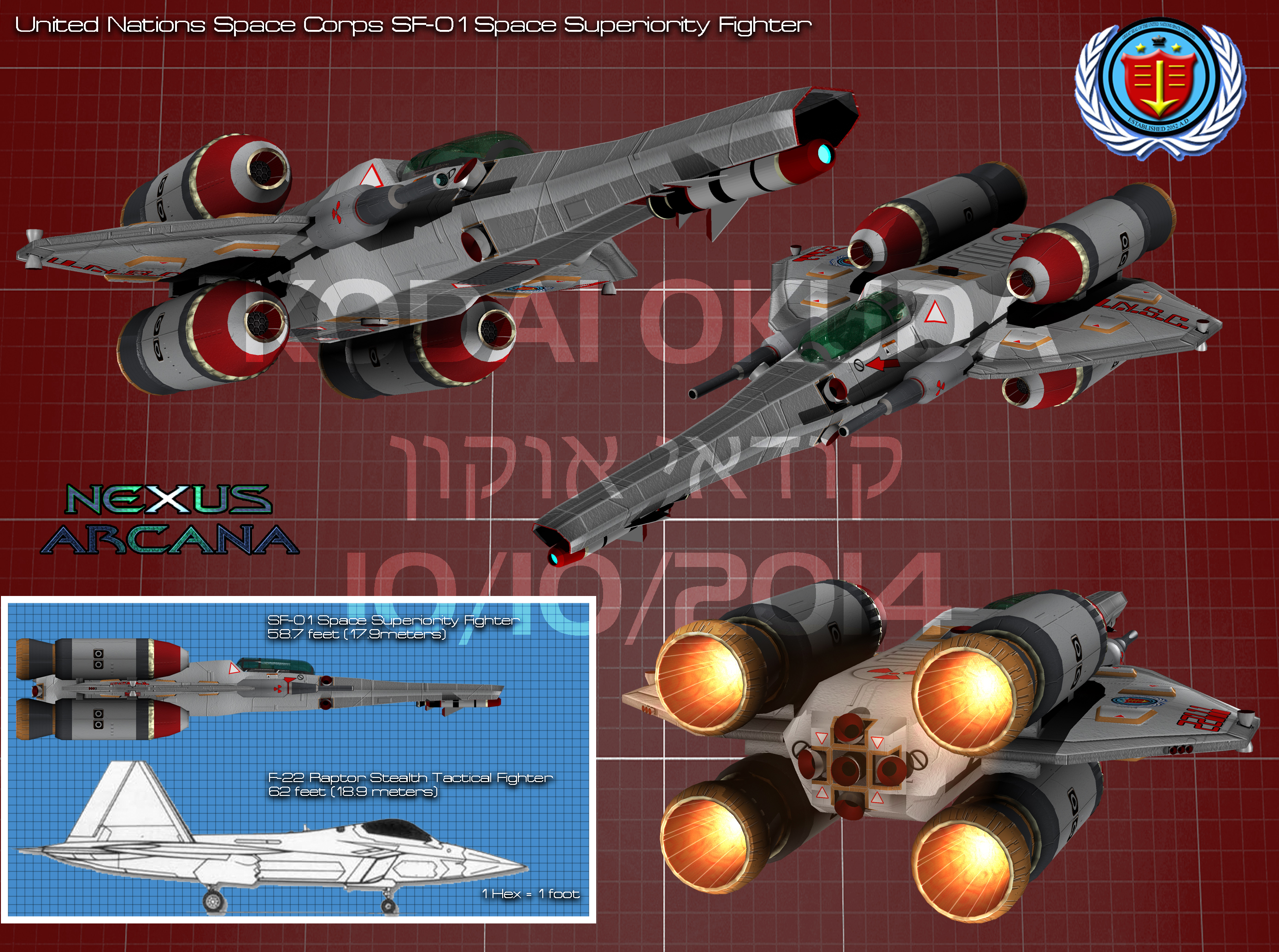SPECIFICATIONS
 GOVERNMENT: United Nations Space Corps
GOVERNMENT: United Nations Space Corps
TYPE: Main Space Superiority fighter
MODEL: Eurospace-Cosmonautics SF-01
DATE INTRODUCED: 2153 AD
LENGTH: 58.7 feet (17.9 meters)
WIDTH: 31.8 feet (9.7 meters)
HEIGHT: 12.1 feet (3.7 meters)
MATERIAL: Composite-Alloy
POWER PLANT: Hensai Energy HENR-50 nuclear reactor
OUTPUT: 50 megawatts
ARMOR TYPE: Composite-Alloy
ARMOR THICKNESS: 3 inches
DISPLACEMENT: 25 tons
CREW: 1 Pilot
PROPULSION
4xEurospace ES-NR-8 nuclear rockets
SPEED: 760 mph each (3040 mph total)
WEAPONS:
PRIMARY (OFFENSIVE):
2x UNRFLC-01 rapid-fire laser cannons; Effective Range: 20 miles; Payload: unlimited nuclear battery with a cyclic rate of 210 blasts every 10 seconds; ROF: up to 1260 blasts per minute in bursts of 42 per discharge.
PRIMARY (DEFENSIVE):
12x UNMML-01 mini-missile launchers; Missile Type: 8-inch computer-guided RPG with HEAP warhead; Effective Range: 17 miles; Payload: 16 rockets each; ROF: any combination of 1 to 5 rockets can be fired at once from each launcher for a total of 60 mini-missiles per salvo.
PRIMARY (ASSAULT):
1xUNNM-25 nuclear missile; Effective Range: 3 miles; Payload: 1 nuclear missile; ROF: 1.
ELECTRONICS:
1x Basic Radio Communications array with a 2500-mile range.
1x RADAR array with a range of 500 miles.
1x Multispectral Video/Optical array with a range of 20 miles.
DEFENSE SYSTEMS:
1x Euroarms ESA-12.5 electrostatic armor generator; Range: 15 feet from hull; Power Requirement: 12.5 megawatts.
Description/Overview:
(SF-01)
The UN SF-01 was conceived in 2152 AD as a cheap, mass-produced space fighter capable of engaging the Earth Federal Forces Kentucky class attack shuttle in combat. The UNSF-01 was an excellent fighter in close-range combat (usually within a fleet formation) near planets and space stations. However, by the outbreak of the 1st Interplanetary War, any SF-01 engaging in fighter-to-fighter combat would be committing suicide. The SF-01 simply could not compete with other space fighters of the 2170s, namely the HSF-01.
(SF-01A)
The UNSF-01 was replaced in 2173 AD by the SF-01A upgraded UN space fighter. This “upgrade” was simply a refit of the existing stockpile of SF-01s in the UNSC inventory and a minor retooling of the SF-01 factories on Vesta, Hygea, and the moons of Mars and Jupiter. The upgrade was intended to act as a “stopgap” measure until the SF-02 and SF-03 could be put into mass production.
The primary differences between the two fighters were the engines and nose-mounted weapon. The SF-01A had its rocket engines replaced by four Senchai-Cydonia SCIE-2.5 high yield ion engines. These engines produced far more thrust than the old rocket engines of the original Great War era fighter. This allowed the SF-01A to compete with the HSF-01 in fighter-to-fighter combat more adequately.
The forward anti-ship missile was replaced on the SF-01A by a Lithgear LG-50AC 50-millimeter autocannon gunpod. This gunpod fired twenty-round bursts within a few seconds. This allowed the SF-01A to lay down a devastating hail of shells at a target, which usually inflicted severe to catastrophic damage. The LG-50A was able to pass through the HSF-01 space fighter’s nuclear dampening fields easily. This gave the SF-01 a new lease on life and made the fighter the choice of nearly all of the spacepirate and outer sphere colonial groups of the post 1st Interplanetary War era.


 GOVERNMENT: United Nations Space Corps
GOVERNMENT: United Nations Space Corps